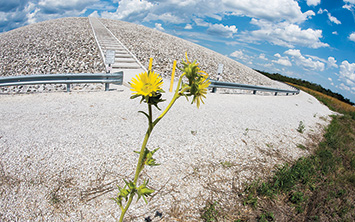Former laborer exposed to radiation, other toxins at Weldon Spring worries what will happen next
Workers eligible for medical screenings, compensation
PART 3 IN A SERIES
By TIM ROWDEN
Editor-in-Chief

Gary Ferguson was 22 years old when he began working on the Weldon Spring Site Remedial Action Project in St. Charles County in the early 1990s. What he was exposed to there would change his life forever.
On the site of the current Weldon Spring Conservation Area in St. Charles County once stood plants that made TNT and DNT during World War II, and produced uranium during the Cold War.
“I was a laborer, and we did all the hazardous waste cleanup and demo-ed the buildings,” Ferguson said. “We were tearing down these buildings on one side of the fence and on the other side of the fence were the picnic tables where we ate lunch. We had to wear PPE when we were working inside the fence, but on the other side they said we were safe, when they were tearing down these buildings like 25 feet away.”
Now 55 and suffering from debilitating asthma and arthritis, Ferguson believes the materials he was exposed to at Weldon Spring are responsible for his health problems.
Ferguson’s father and brothers also worked at the site. His father died of a rare form of cancer that affected the platelets in his blood. Prior to his fatal illness, he developed severe neuropathy that kept him almost chair bound.
One of his brothers now has neuropathy and cancer. His other brother worked in an office space and doesn’t’ appear to have any health problems.
Their mother died of rare form Lupus, which the family believes was caused by her washing her husband’s clothes while they were working at Weldon Spring.
Several of his coworkers, including his former boss have died of unique cancers, which Ferguson worries will be his fate as well.
“If we had known then what we know now, we would have never worked out there,” Ferguson said. “I would have my family. I would say 80 to 85 percent of everybody who worked out there has something wrong with them. It’s the saddest thing I’ve ever seen.”
A single father with two daughters, ages nine and 11, Ferguson worries what will happen to his daughters if his health deteriorates further.
COMPENSATION
Ferguson is one of about 5,000 workers who were employed at Weldon Spring over the course of the demolition and remediation project.
He and other tradesmen and women who worked at Weldon Spring and on other Department of Energy (DOE) sites in other areas are eligible for free medical screenings and compensation they may be due as a result of the materials they were exposed to under the Energy Employees Occupational Illness Compensation Program Act.
The Act, passed by Congress in 2000, established a fund to compensate workers and their families who were made ill or died due to their work in nuclear weapons facilities or working on remediation and cleanup of former sites, with up to $400,000 in compensation, plus medical benefits provided.
The act applies to any worker who may have suffered exposures while working at former Department of Energy (DOE) sites.
Funding for the program comes from the U.S. Treasury Department and is called by some an “Apology Payment” to those who did this dangerous work.
Ferguson received a screening and compensation for his asthma, which was determined to be an 85 percent disability but did not qualify him for federal medical disability support. Now that he has arthritis, it is even more difficult for him to work, and he worries what will happen next.
“These cancers hit these people so fast. What’s going to happen if something hits me? My kids are going to be lost.”
‘A BAD EXPOSURE’
Ferguson worked on the Weldon Spring site from 1990 to 1994.
“Probably the whole time anybody worked there was a bad exposure,” he said.
“We wore these dosimetry badges that measured our (radiation) exposure on the way in and way out,” he said. “If they were really bad they would take the old one off and put a new one on and test that one.”
Ferguson suffered a serious exposure on the job site when he and another worker slipped and fell into a containment pond.
“We built these water containment ponds that we had to put in to siphon the water off the main pit where we buried everything. Two of us slipped and fell down that embankment and into that sludge pond and when we got out, they stripped us down naked in front of everybody and threw all our clothes in a plastic bag and they all scrubbed us off with scrub brushes. They told us if they couldn’t get this off they were going to put us in container and send us to Colorado.
“The whole time I worked out there I got nosebleeds,” Ferguson said. “My boss told me he was having nosebleeds too, but told me not to say anything. He wound up dying of a rare cancer.
“Back in 1990, we were making $25 an hour,” Ferguson said. “That was a lot of money then. But if we had known then what we do today, we would have never worked out there. I would have my family.”
GET SCREENED
Denise Brock, ombudsman to the Centers for Disease Control and Prevention’s National Institute for Occupational Safety and Health (NIOSH) is working to get the word out to building trades members about the free medical screenings and compensation they may be due as a result of their exposure at Weldon Spring and other DOE sites.
“This is about these workers,” Brock said. “I want to get the word out to the building trades construction, maintenance, secretaries, truck drivers – anybody who worked out there.”
In Missouri, 939 trades members have already been screened and in Illinois, 145 have been screened.
Brock says those numbers are low compared to the believed number of workers who were exposed in construction, dismantling and remediation/clean-up at sites like the Mallinckrodt Weldon Spring Plant, Mallinckrodt Chemical Company Destrehan Street Facility (downtown St. Louis), the St. Louis Airport Storage Site and others, including sites in other states where local workers may have traveled for jobs.
Tradesmen and women that may be eligible for compensation for having worked on these sites include boilermakers, carpenters, electricians, iron workers, laborers, pipefitters and others.
FIND OUT IF YOU QUALIFY
The Building Trades National Medical Screening Program (BTMed) is a database that provides a listing of contractors and subcontractors with a known contractual relationship with various Department of Energy (DOE) facilities that are covered under the Compensation Program Act. It includes subcontractors on the Mallinckrodt Weldon Spring Plant, Mallinckrodt Chemical Company Destrehan Street Facility (downtown St. Louis), the St. Louis Airport Storage Site, as well as sites in other states where local workers may have traveled for jobs.
The U.S. Department of Energy and Department of Labor compiled and updated a list of contractors who worked on those sites to identify which workers may be at risk and added contractors whose employees may have been at risk if their company isn’t currently listed.
The Energy Employees Occupational Illness Compensation Program Act covers any illness that can be caused by, aggravated by or contributed to by toxic exposure.
More information is available at www.btmed.org or by contacting BTMed at 800-866-9663 or Denise Brock at 636-236-0932.



One Comment
Has anybody tested the cylotron at WASHINGTON UNIVERSITY main campus next door to the power plant ? That’s is where they developed the trigger part of the atomic bomb. There is a fenced in area on Forsyth with nothing inside that has radioactive waste in the soil. South side of Forsyth across from main campus.